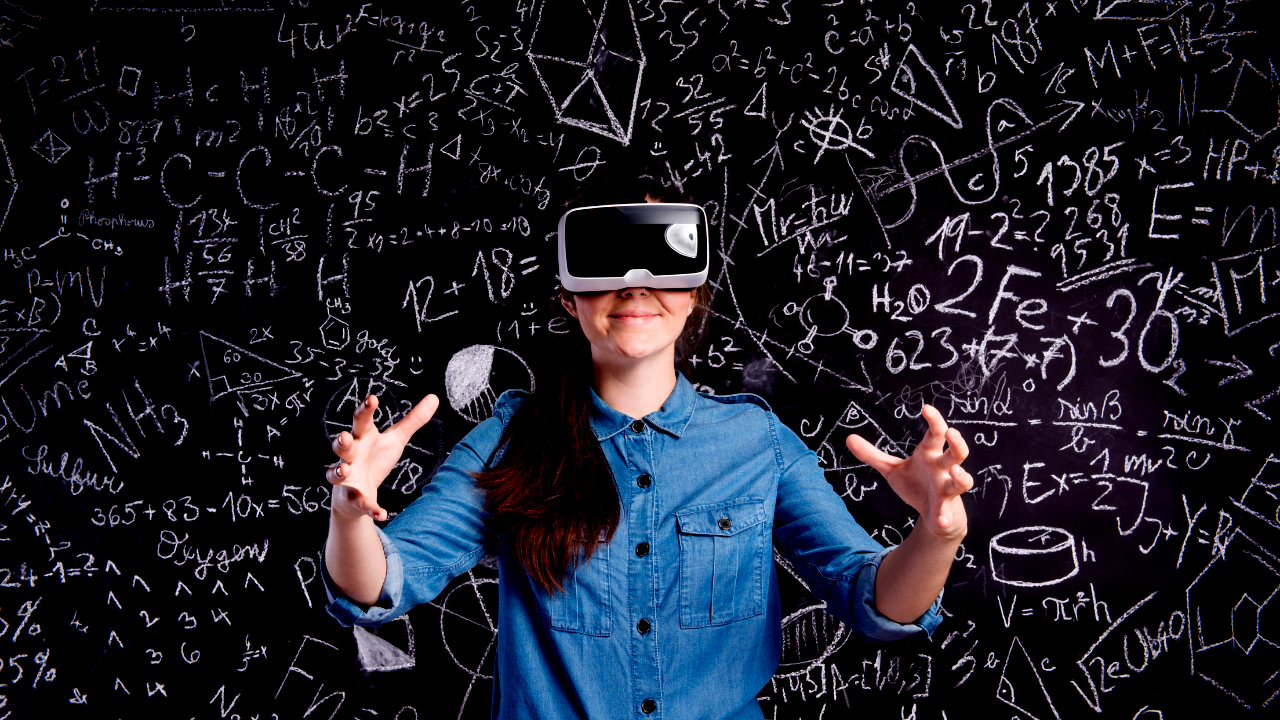Listen to this article here.
A recent TikTok post went viral with millions of views showing a kindergarten teacher in action in her virtual classroom. The teacher, Mackenzie Adams, posted the short clip of herself after filming it to get an idea of what she looked like while teaching. What started as more of a reflection tool turn into a lesson on what it takes to engage students in the age of virtual classrooms.
In an interview, the teacher said, "I honestly just wanted to see what I looked like while teaching, kind of just as a reflection tool. I wanted to see, 'Am I being energetic enough for them? Am I engaging enough?'"
Managing Surprises With A Positive Attitude
The sudden shift to virtual classrooms has been overwhelming for many students and parents stuck at home, and many teachers are equally frustrated with the new set of challenges they face. But teachers like Mackenzie Adams offer hope that success is still possible.
Exaggerated expressions, a positive attitude, and an endless smile are valuable tools of the trade for teachers who want to provide their students with an engaging learning experience in virtual settings, and as a professional magician for over two decades I learned the importance of using these same engagement tactics to maintain attention, interest, desire, action, and satisfaction during my performances.
When you have a room full of people relying on you for a delightful experience, there’s no room for errors and missteps—for example, when a child says something inappropriate, an intoxicated adult vies for attention, your activity fails, or the person assisting you simply isn’t able to follow directions, perhaps due to some unforeseen accessibility issues. Being able to maintain a positive attitude even during unplanned complications is vital for the audience’s continued satisfaction with their experience.
Virtual Classroom Tips
When I transitioned my career from magic as entertainment to magic as education and transformation, I discovered that there’s a lot of overlap between engagement tactics used in the theatre and the classroom, and this is true whether it’s in the face-to-face or virtual classroom. I would suggest, however, that these tactics are even more vital in virtual settings. These tactics include (but are not limited to):
These are just a sampling of the overlap in engagement techniques used in both performance and education. For a deeper understanding of these techniques, let’s take another look at a concept I mentioned earlier in passing, when I mentioned how I use attention, interest, desire, action, and satisfaction (AIDAS) in my performances. This is a theory commonly used in sales, however in my experience it works equally well in performance, and I include teaching as a form of performance. Here’s how it works:
1. Attention
In an interview, the teacher said, "I honestly just wanted to see what I looked like while teaching, kind of just as a reflection tool. I wanted to see, 'Am I being energetic enough for them? Am I engaging enough?'"
Managing Surprises With A Positive Attitude
The sudden shift to virtual classrooms has been overwhelming for many students and parents stuck at home, and many teachers are equally frustrated with the new set of challenges they face. But teachers like Mackenzie Adams offer hope that success is still possible.
Exaggerated expressions, a positive attitude, and an endless smile are valuable tools of the trade for teachers who want to provide their students with an engaging learning experience in virtual settings, and as a professional magician for over two decades I learned the importance of using these same engagement tactics to maintain attention, interest, desire, action, and satisfaction during my performances.
When you have a room full of people relying on you for a delightful experience, there’s no room for errors and missteps—for example, when a child says something inappropriate, an intoxicated adult vies for attention, your activity fails, or the person assisting you simply isn’t able to follow directions, perhaps due to some unforeseen accessibility issues. Being able to maintain a positive attitude even during unplanned complications is vital for the audience’s continued satisfaction with their experience.
Virtual Classroom Tips
When I transitioned my career from magic as entertainment to magic as education and transformation, I discovered that there’s a lot of overlap between engagement tactics used in the theatre and the classroom, and this is true whether it’s in the face-to-face or virtual classroom. I would suggest, however, that these tactics are even more vital in virtual settings. These tactics include (but are not limited to):
- Maintain eye-contact (don’t look at the computer screen, look at the camera).
- Use exaggerated facial expressions.
- Speak clearly
- Make sure everyone can see you and the presentation materials (keep everything in frame)
- Use the improv technique of “Yes, and…” to manage surprises (this prevents students from getting sidetracked).
- Make everyone feel valued, important, and appreciated.
These are just a sampling of the overlap in engagement techniques used in both performance and education. For a deeper understanding of these techniques, let’s take another look at a concept I mentioned earlier in passing, when I mentioned how I use attention, interest, desire, action, and satisfaction (AIDAS) in my performances. This is a theory commonly used in sales, however in my experience it works equally well in performance, and I include teaching as a form of performance. Here’s how it works:
1. Attention
As a magician, before I speak on stage I must be sure that I have everyone’s attention. This can happen in a number of ways, including having a host introduce me and announce the start of the show.
As an educator, facilitator, and social-emotional skills coach, I can use this same attention-grabbing technique in a virtual classroom setting, by playing music, clapping, ringing a bell, or playing the ukulele (my new favorite attention-grabbing technique). The idea is to use a clear signal that something different is happening and this sudden change is what generates the initial attention to get started. The key is to make it quick, because attention wanes quickly, especially in virtual settings.
Application Reflection Question: What techniques do you use to gain attention from your students?
2. Interest
As an educator, facilitator, and social-emotional skills coach, I can use this same attention-grabbing technique in a virtual classroom setting, by playing music, clapping, ringing a bell, or playing the ukulele (my new favorite attention-grabbing technique). The idea is to use a clear signal that something different is happening and this sudden change is what generates the initial attention to get started. The key is to make it quick, because attention wanes quickly, especially in virtual settings.
Application Reflection Question: What techniques do you use to gain attention from your students?
2. Interest
After gaining attention, the next step is to generate interest. Interest can be generated in a number of ways, including the exploitation of incongruity. This is used to great effect in magic shows since magic inherently highlights the incongruity between perception, assumptions, and reality.
As educators, we can use this tactic by telling an engaging story, by stating a shocking fact, or perhaps by engaging students in an exploratory game or activity that feeds into their mind’s natural tendency for curiosity, connections, and organizing thoughts.
Application Reflection Question: What techniques can you use to generate interest from your students for what you have to share with them?
3. Desire
As educators, we can use this tactic by telling an engaging story, by stating a shocking fact, or perhaps by engaging students in an exploratory game or activity that feeds into their mind’s natural tendency for curiosity, connections, and organizing thoughts.
Application Reflection Question: What techniques can you use to generate interest from your students for what you have to share with them?
3. Desire
To sustain interest it must be transformed into desire, whether a desire to know more, experience more, or get involved somehow. The education psychologist John Keller provides some insight for how to turn attention and interest into desire with his motivational model known as ARCS, which stands for Attention, Relevance, Confidence, and Satisfaction. You’ll notice that there’s quite an overlap between ARCS and AIDAS, and I often use them interchangeably by using relevance techniques to generate desire.
In a magic show I might use stage props, storylines, and comedy to demonstrate relevance for the audience. For example, if I’m working for a company, I may invite the CEO or president to help make the magic happen. Talk about relevance and desire! Everyone will be fixated on what happens next because someone very important (and relevant) to them is involved in a new situation, creating an emotional pull.
As educators, we can similarly make course material desirable by making it relevant to the real-life concerns that our students care about. This level of customization takes effort, but it’s worth the effort to create an emotion hook.
Application Reflection Question: What might you do to generate a burning desire within your students for what you have to share with them?
4. Action
In a magic show I might use stage props, storylines, and comedy to demonstrate relevance for the audience. For example, if I’m working for a company, I may invite the CEO or president to help make the magic happen. Talk about relevance and desire! Everyone will be fixated on what happens next because someone very important (and relevant) to them is involved in a new situation, creating an emotional pull.
As educators, we can similarly make course material desirable by making it relevant to the real-life concerns that our students care about. This level of customization takes effort, but it’s worth the effort to create an emotion hook.
Application Reflection Question: What might you do to generate a burning desire within your students for what you have to share with them?
4. Action
Once desire has been established, the next step is to get the audience to take action. In a magic show this usually means getting an audience participant to join in making the magic happen. As educators we can use this technique by having students play a game, try a simulation, or some other engaging activity that will help them to feed their curiosity while also filling in their knowledge and skills gap in a meaningful and relevant way.
Application Reflection Question: What call-to-action can you use to inspire students to discover and apply knowledge and skills in a relevant and meaningful way?
5. Satisfaction
Application Reflection Question: What call-to-action can you use to inspire students to discover and apply knowledge and skills in a relevant and meaningful way?
5. Satisfaction
Once action has taken place, the last step in the cycle is to ensure everyone is satisfied with the experience. In a magic show I do this by giving it my all in every performance and then personally thanking everyone for being a part of the experience. If it’s a small group I’ll actually go person-to-person to talk with everyone, and if it’s a big group I’ll stand at the exit to speak with everyone on their way out. People sincerely appreciate the genuine personal touch to know that I care about them, giving them confidence in their decision to be a part of the experience and therefore more likely to do it again and tell others about the great time they had.
As educators we can go even a step further by again turning to John Keller’s ARCS model, this time incorporating confidence-building techniques. In my view, students won’t truly be satisfied with a learning experience unless they feel confident, which is why I simply roll these two ideas into one. One way to build confidence within students is to allow them time to reflect on what they learned, discuss their questions and ideas with peers, and then plan their next steps.
In virtual classroom settings this technique can easily be employed by using the “breakout room” feature. I like to break students into small groups of at least three, but no more than five. This way everyone will have an opportunity to share their questions and ideas to gain perspective from their peers while deepening their learning. What I like to do is have everyone write down their key takeaways and submit them in the chat box so everyone can see what other groups discussed. And then finally, before the end of the virtual session, I give students time to write down what their next steps will be, helping them to be confident in what’s expected of them and satisfied in their ability to follow through. Using this tactic, or some variation of it, can go a long way for building confidence and satisfaction within learners.
Application Reflection Question: What will you do to ensure your students are confident and satisfied with their learning experience and newly gained knowledge and skills?
Final Thoughts
The sudden shift to virtual classrooms has been overwhelming for many, including teachers, students, and parents. By engaging in the practices suggested here, educators can be empowered and encouraged to help their students gain continued confidence and satisfaction in their learning experience for life-long growth and development.
As educators we can go even a step further by again turning to John Keller’s ARCS model, this time incorporating confidence-building techniques. In my view, students won’t truly be satisfied with a learning experience unless they feel confident, which is why I simply roll these two ideas into one. One way to build confidence within students is to allow them time to reflect on what they learned, discuss their questions and ideas with peers, and then plan their next steps.
In virtual classroom settings this technique can easily be employed by using the “breakout room” feature. I like to break students into small groups of at least three, but no more than five. This way everyone will have an opportunity to share their questions and ideas to gain perspective from their peers while deepening their learning. What I like to do is have everyone write down their key takeaways and submit them in the chat box so everyone can see what other groups discussed. And then finally, before the end of the virtual session, I give students time to write down what their next steps will be, helping them to be confident in what’s expected of them and satisfied in their ability to follow through. Using this tactic, or some variation of it, can go a long way for building confidence and satisfaction within learners.
Application Reflection Question: What will you do to ensure your students are confident and satisfied with their learning experience and newly gained knowledge and skills?
Final Thoughts
The sudden shift to virtual classrooms has been overwhelming for many, including teachers, students, and parents. By engaging in the practices suggested here, educators can be empowered and encouraged to help their students gain continued confidence and satisfaction in their learning experience for life-long growth and development.
Want More?
Schedule an exploratory positivity call! Or, become a member of Hashtag Positivity to access exclusive resources to help you and the people you serve manage positive change for your growth and development.
Jonas Cain is a Learning Experience Designer and Facilitator of Fascination for Hashtag Positivity, providing valuable social emotional knowledge, skills, resources, and support to emerging leaders and their influencers to help them enter the next chapter of their lives with clarity, confidence, courage, and joy.
Views: 31
Comment
© 2024 Created by MyPeace Media.
Powered by
![]()





You need to be a member of MyPeace.TV to add comments!
Join MyPeace.TV